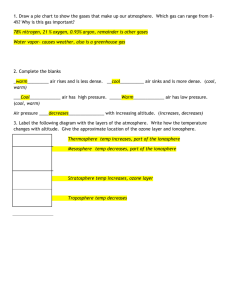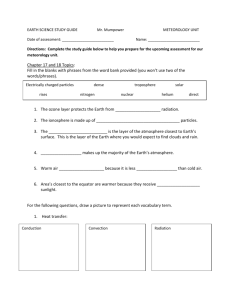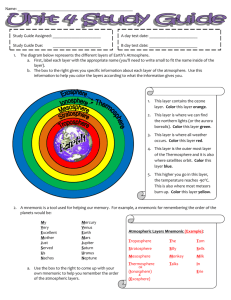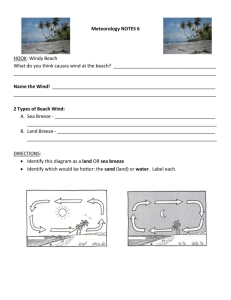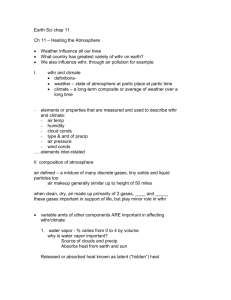two homework sheets
advertisement
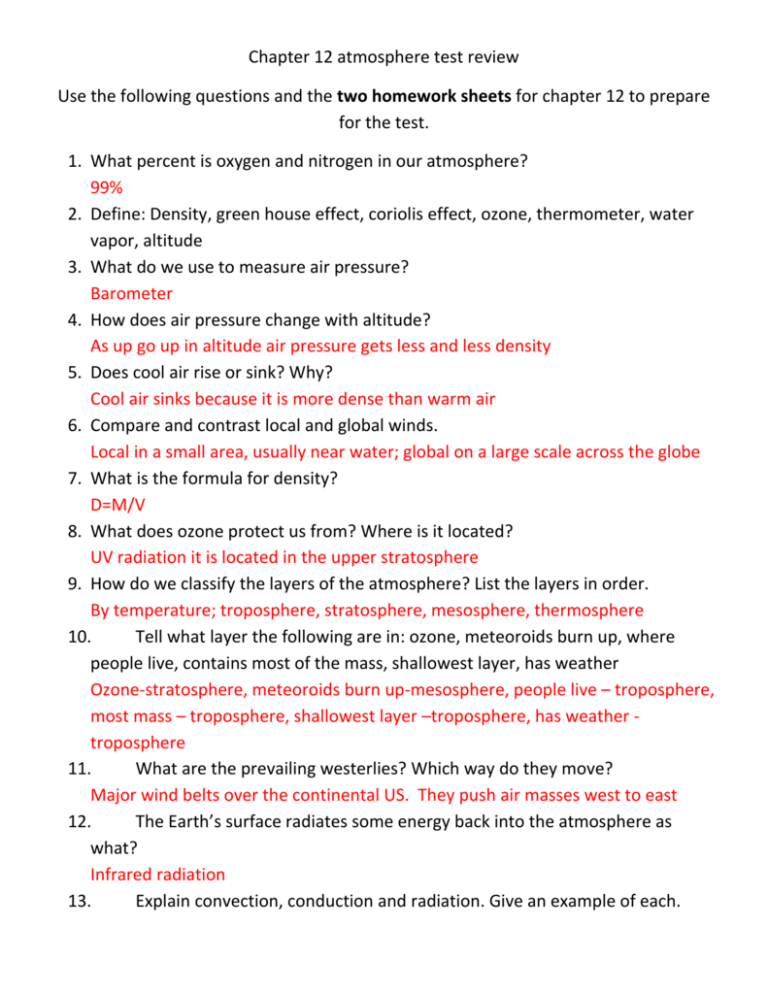
Chapter 12 atmosphere test review Use the following questions and the two homework sheets for chapter 12 to prepare for the test. 1. What percent is oxygen and nitrogen in our atmosphere? 99% 2. Define: Density, green house effect, coriolis effect, ozone, thermometer, water vapor, altitude 3. What do we use to measure air pressure? Barometer 4. How does air pressure change with altitude? As up go up in altitude air pressure gets less and less density 5. Does cool air rise or sink? Why? Cool air sinks because it is more dense than warm air 6. Compare and contrast local and global winds. Local in a small area, usually near water; global on a large scale across the globe 7. What is the formula for density? D=M/V 8. What does ozone protect us from? Where is it located? UV radiation it is located in the upper stratosphere 9. How do we classify the layers of the atmosphere? List the layers in order. By temperature; troposphere, stratosphere, mesosphere, thermosphere 10. Tell what layer the following are in: ozone, meteoroids burn up, where people live, contains most of the mass, shallowest layer, has weather Ozone-stratosphere, meteoroids burn up-mesosphere, people live – troposphere, most mass – troposphere, shallowest layer –troposphere, has weather troposphere 11. What are the prevailing westerlies? Which way do they move? Major wind belts over the continental US. They push air masses west to east 12. The Earth’s surface radiates some energy back into the atmosphere as what? Infrared radiation 13. Explain convection, conduction and radiation. Give an example of each. Convection- in a fluid (Hot air rises in a room), conduction- must be touching (when you touch a hot spoon the heat is transferred to your hand), radiation- can travel in a vacuum in rays or waves (when you get a sun burn). 14. Energy from the sun that reaches Earth is mostly in the form of what? Infrared radiation, visible light, ultraviolet radiation 15. Compare an aneroid barometer and a mercury barometer. Aneroid – has a metal chamber that is sensitive to pressure changes, Mercury – has a cup filled with mercury and a tube that the mercury gets pushed into as pressure gets higher 16. As you climb a mountain explain why it gets harder to breath. Less oxygen molecules the higher you go 17. Draw a diagram showing a land breeze and showing a sea breeze. Land breeze – temp of land less than temp of water Sea breeze – temp of water less than temp of land 18. On a summer day, the Sun heats land near the ocean. This causes the air over the land to rise into the upper atmosphere. Describe what affect this will have on the breeze in that area and what will it cause? A sea breeze occurs as cooler air over the ocean replaces some of the rising air. 19. Explain this statement: At night, a sea breeze often switches direction and becomes a land breeze. The temp of the water changes much more slowly than the temp of the land 20. Which substance in the stratosphere absorbs sunlight and causes the increase in temperature with altitude? Ozone 21. How do greenhouse gases affect the troposphere? Greenhouse gases absorb heat radiation from Earth’s surface

